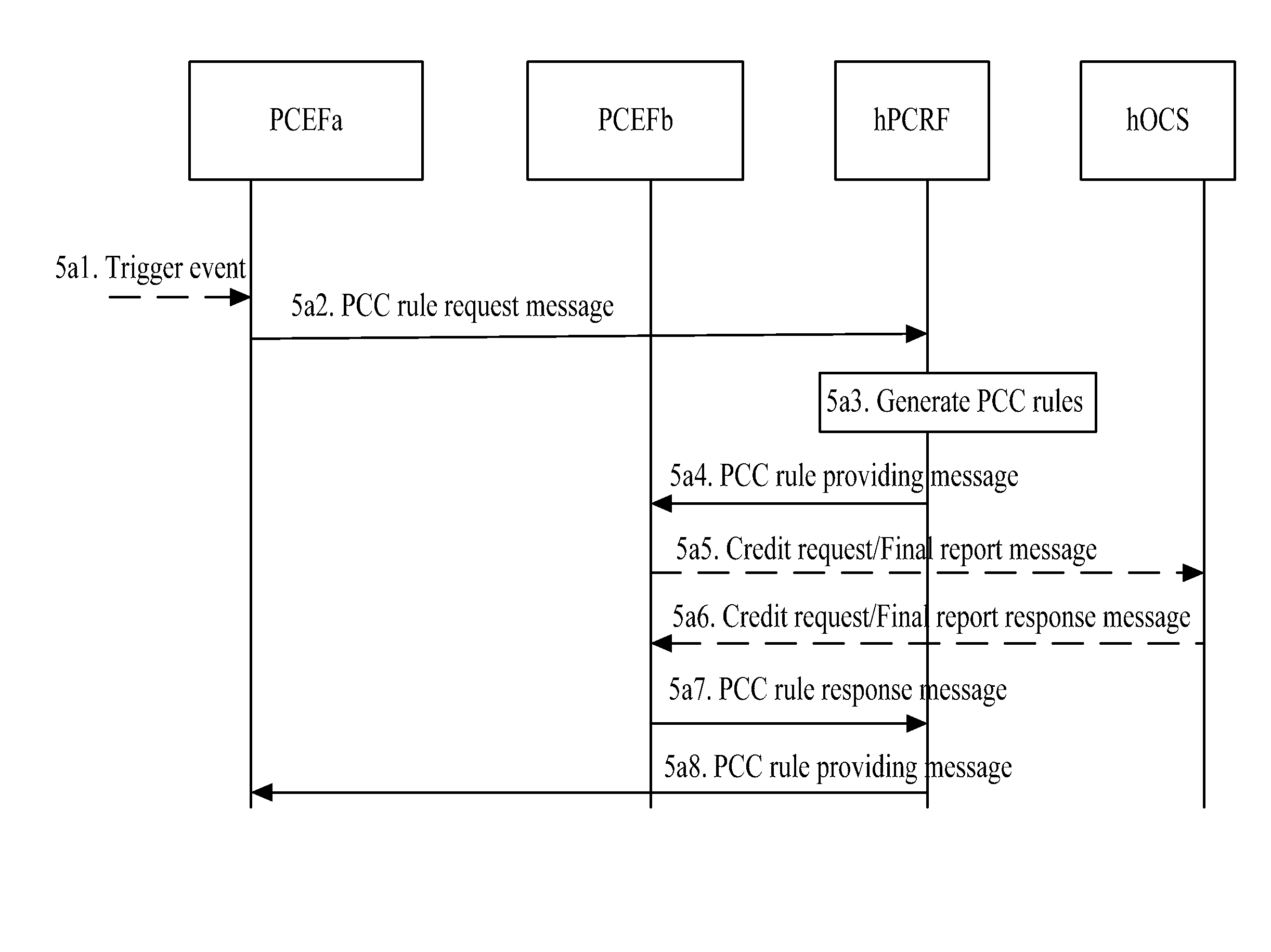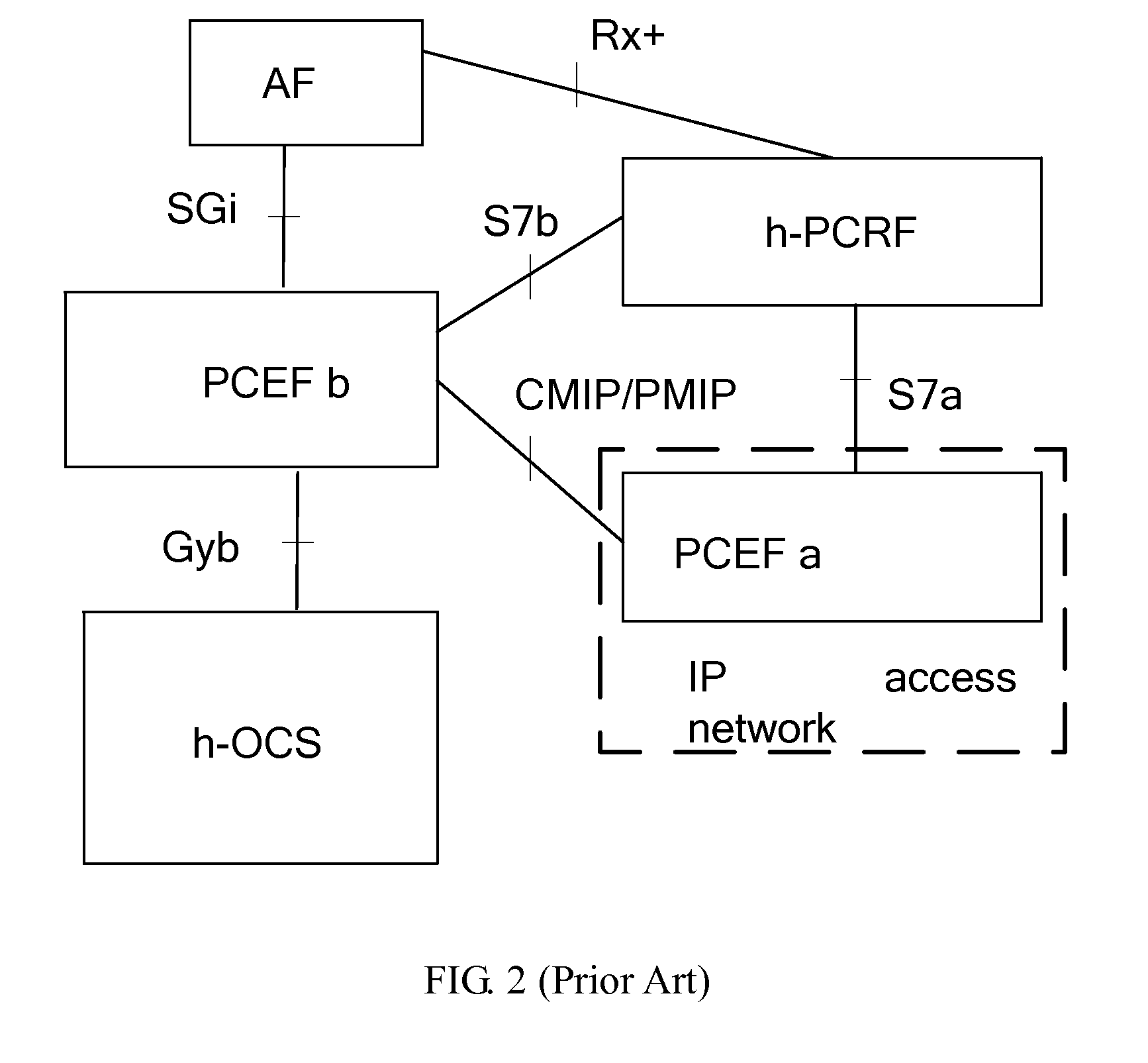Method and System for Session Modification
a session modification and session technology, applied in the field of communication technologies, can solve problems such as inability to ensur
- Summary
- Abstract
- Description
- Claims
- Application Information
AI Technical Summary
Benefits of technology
Problems solved by technology
Method used
Image
Examples
first embodiment
[0047]The first embodiment implements IP-CAN session modification and credit re-authorization based on a non-roaming PCC architecture shown in FIG. 2.
[0048]In the PCC architecture shown in FIG. 2, the PCEF a and PCEF b both receive a trigger event delivered from the h-PCRF. The PCEF a may receive a trigger event in one of the following modes:
[0049]the h-PCRF directly delivers the trigger event to the PCEF a; and
[0050]the h-PCRF delivers the trigger event to the PCEF b, and then the PCEF b sends the bearer-related trigger event information to the PCEF a.
[0051]The h-OCS sends credit re-authorization events to only the PCEF b and no credit re-authorization event is available on the PCEF a.
[0052]Thus, when an event that occurs matches a trigger event, the PCEF a and PCEF b may both initiate an IP-CAN session modification process. When an event that occurs matches a credit re-authorization event, however, only the PCEF b initiates a credit re-authorization process.
[0053]The h-PCRF may se...
second embodiment
[0091]The second embodiment implements IP-CAN session modification and credit re-authorization based on a roaming PCC architecture shown in FIG. 3.
[0092]In the PCC architecture shown in FIG. 3, the PCEF a and PCEF b both receive the trigger event delivered from the h-PCRF. The PCEF a may receive a trigger event in one of the following modes:
[0093]the h-PCRF directly sends the trigger event to the PCEF a; and
[0094]the h-PCRF sends the trigger event to the PCEF b, and then the PCEF b sends the bearer-related trigger event information to the PCEF a.
[0095]The h-OCS sends credit re-authorization events to only the PCEF b and no credit re-authorization event is available on the PCEF a.
[0096]Thus, when an event that occurs matches a trigger event, the PCEF a and PCEF b both may initiate an IP-CAN session modification process. When an event that occurs matches a credit re-authorization event, however, only the PCEF b initiates a credit re-authorization process.
[0097]In this embodiment, the ...
third embodiment
[0147]The third embodiment implements IP-CAN session modification and credit re-authorization based on a roaming PCC architecture shown in FIG. 4.
[0148]As shown in FIG. 4, the PCEF a, PCEF b1, and PCEF b2 receive the trigger events delivered from the h-PCRF respectively. The h-PCRF may deliver the trigger events to the PCEF a through the v-PCRF. The h-PCRF may also deliver the trigger events to the PCEF b2, and then the PCEF b2 sends the bearer-related trigger events to the PCEF a through the PCEF b1. The h-OCS sends credit re-authorization events only to the PCEF b2 and no credit re-authorization events are available on the PCEF a and PCEF b1. Thus, when an event that occurs matches a trigger event, the PCEF a, PCEF b1, and PCEF b2 may initiate an IP-CAN session modification process respectively. When an event that occurs matches a credit re-authorization event, however, only the PCEF b2 initiates a credit re-authorization process.
[0149]In this embodiment, the h-PCRF may send PCC r...
PUM
 Login to View More
Login to View More Abstract
Description
Claims
Application Information
 Login to View More
Login to View More - R&D
- Intellectual Property
- Life Sciences
- Materials
- Tech Scout
- Unparalleled Data Quality
- Higher Quality Content
- 60% Fewer Hallucinations
Browse by: Latest US Patents, China's latest patents, Technical Efficacy Thesaurus, Application Domain, Technology Topic, Popular Technical Reports.
© 2025 PatSnap. All rights reserved.Legal|Privacy policy|Modern Slavery Act Transparency Statement|Sitemap|About US| Contact US: help@patsnap.com



